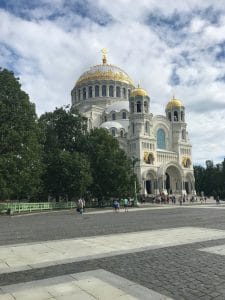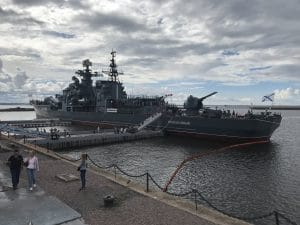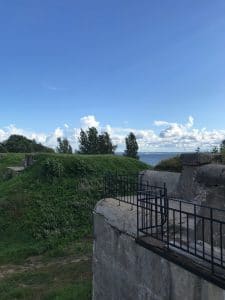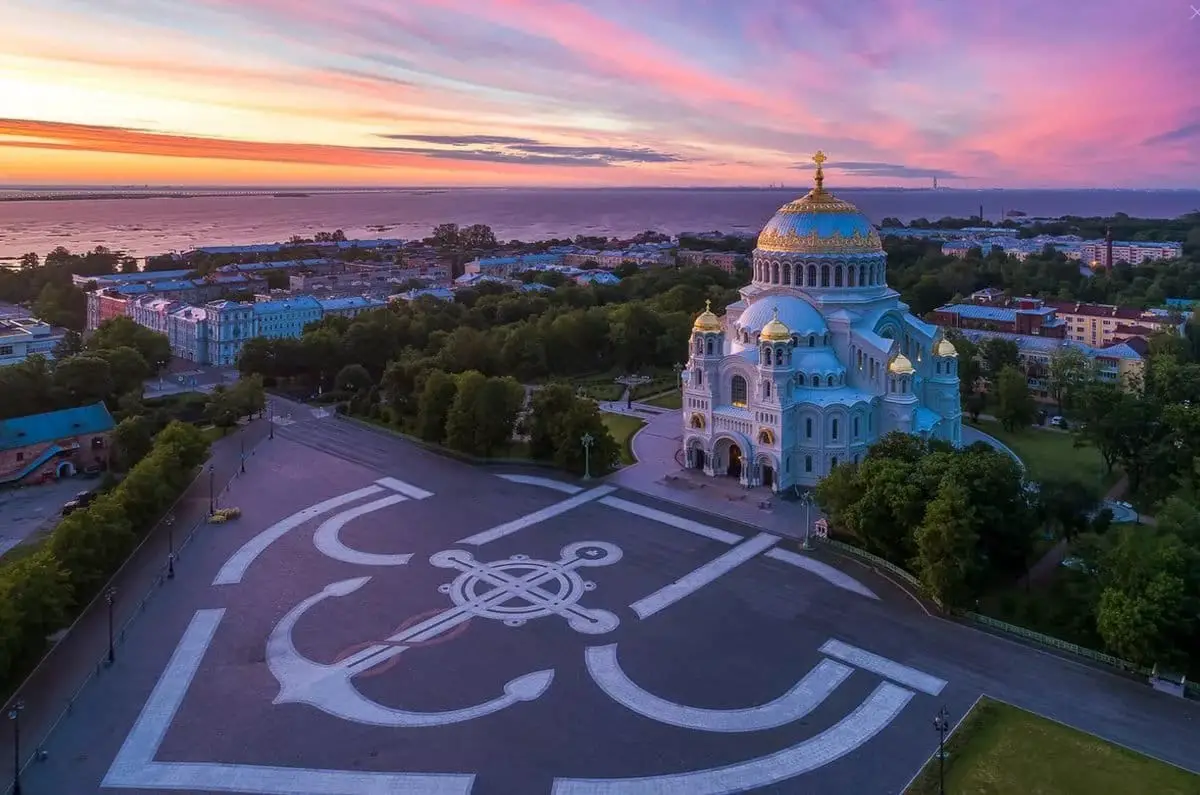Located on Kotlin Island, some 20 miles west of Saint Petersburg, the city of Kronstadt and surrounding fortifications are grouped under the UNESCO World Heritage Site “Historic Centre of Saint Petersburg and Related Groups of Monuments.”
Much of the island is currently being reconstructed as a major tourist center focused on Russia’s naval history. A cluster of new and renovated buildings, parks, and monuments call attention to the role that Kronstadt has played as the seat for the Imperial Russian Navy’s administration, the historic Baltic Fleet headquarters, and the site of important events during the Russian Civil War and the Second World War. The result is not just a massive beautification effort, but also an attempt to make visitors feel a part of this history, examining and interacting freely with its artifacts, and walking through locations that, while feeling modern, also broadcast their histories at nearly every turn.
The city can be accessed by bus via a highway built into the Saint Petersburg Dam. A list of bus stops, their cost, and a time-table can be found on the city of Kronstadt’s tourism website. The drive out to the island is short but pleasant (depending on the weather), with a range of scenery to enjoy depending on which highway you take out of the city. Leaving from St. Petersburg via the southern Petrodvortsovy District you drive past many famous palaces, from Peterhof to Konstantin Palace which serves as the President of Russia’s Saint Petersburg residence. Taking the northern route through the Primorsky District you have the chance to see the Lakhta Center up close, which once completed will be the second tallest building in Europe. The drive allows you to catch a view of the handful of other fortresses that dot the bay, built on artificial islands that were constructed for the sole purpose of defending Peter the Great’s new capital after he took the lands from Sweden in 1703.

History shows that Kronstadt and the other fortifications fulfilled their role rather well. Aside from providing a deterrent to Sweden, the fortresses also played a significant part in the lesser-known Baltic Campaign of the Crimean War in preventing the Anglo-French fleet from taking the Imperial capital. The city was also critical in the defense of Leningrad (now Saint Petersburg) during the Second World War, an act that earned it the status of “City of Military Glory” in 2009. The honor is given to cities whose defenders showed “courage, steadfastness, and mass heroism” during the war, which Kronstadt displayed in its fight to prevent any naval landing from bringing troops closer to the Leningrad and threatening the city.
The city’s military history is honored in a variety of ways. The island is dotted with numerous related monuments. The newly-opened Peter’s Park, named after Peter the Great, features a statue of Russia’s first emperor surrounded by cannons to commemorate the role he had in establishing Russia’s navy. Near the park is an interesting plaque thanking the Japanese citizens of the island of Miyajima. In 1854 a delegation under Admiral Yevfimiy Putyatin was negotiating treaties in Japan when his fleet was sunk by a tsunami. Thankfully the villagers of Miyajima were able to save the crew. A marker not far from this plaque notes that in the near future a memorial to the divers and sailors who from 1941-1962 lost their lives clearing the Gulf of Finland from mines and ordinance during and following the Second World War.

A short walk from the park is another important site, the Naval Cathedral of Saint Nicholas. Opened in 1913, the Cathedral was unable to serve its intended role for long following the establishment of the Soviet Union the Cathedral served as a movie theater, a watchtower, a concert hall, and eventually as a branch of the Central Naval Museum. After the collapse of the U.S.S.R., while the Russian Orthodox Church attempted to reclaim the church, it was used as a nightclub. A cross was eventually restored to the top in 2002 and, in 2005, the Church returned to service. However, it wasn’t until 2013 that it was fully restored and reconsecrated in a ceremony attended by Prime Minister Dimitri Medvedev. Today, inside the large church, alongside the traditional byzantine-style art and relics, large plaques showing the names of sailors who died in battle hang on the walls of the church. It is fitting as the church was originally built for the sailors at Kronstadt.

The island also hosts multiple museums dedicated to the city’s naval history. A free open-air museum near Peter’s Park features a wide variety of Russian/Soviet naval equipment such as guns, ordinance, submarines, and ships themselves. Visitors can interact with these items, even climbing into any of the handful of submarines, sitting in the gunner’s seat for the anti-aircraft cannons, and boarding the ships. One Sovremennyy-class destroyer, the Bespokoynyy (or Restless), has been turned into a “museum ship.” Onboard, you can get an up-close look at the equipment and weaponry used by the Russian/Soviet Navy on a destroyer that is less than 30 years old.
On the other side of the island, down a few dirt roads on a less developed and uninhabited part of the island, Park Patriot is currently being developed as yet another free, interactive museum. Getting to the park can be difficult, even with a car, as the area is not well mapped on apps yet but it is worth the visit. The Park is built around several of the island’s coastal batteries. Numerous bunkers, cannons, and observation posts can be visited and examined as one strolls the shore. A reconstruction of the living quarters for the soldiers who manned the batteries is currently being built. The park also features ranges for shooting and archery, allowing visitors to test their skills.
Kronstadt is an increasingly attractive side trip from St. Petersburg, especially for anyone interested in military history. Its developing infrastructure gives an immersive and hands-on look at the area’s historic military importance and displays Russian military traditions in a way that leaves no doubt that they continue to live on.






